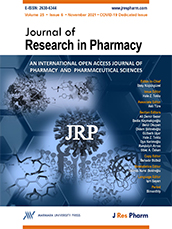Editor-in-Chief
Hatice Kübra Elçioğlu
Vice Editors
Levent Kabasakal
Esra Tatar
Online ISSN
2630-6344
Publisher
Marmara University
Frequency
Bimonthly (Six issues / year)
Abbreviation
J.Res.Pharm.
Former Name
Marmara Pharmaceutical Journal
Journal of Research in Pharmacy
2021 , Vol 25 , Issue 6
Evaluation of molnupiravir analogues as novel coronavirus (SARS-CoV-2) RNA-dependent RNA polymerase (RdRp) inhibitors – an in silico docking and ADMET simulation study
1Department of Pharmaceutical Chemistry, Faculty of Pharmacy, Marmara University, Başıbüyük 34854 İstanbul, Turkey2Department of Pharmaceutical Toxicology, Faculty of Pharmacy, Marmara University, Başıbüyük 34854 İstanbul, Turkey DOI : 10.29228/jrp.93 The severe acute respiratory syndrome coronavirus 2 (SARS-CoV-2), which is characterized by a wide range of symptoms including fever, dry cough, headache, decreased sense of taste and smell, was first identified in Wuhan, China in December 2019. Currently, the nucleoside analog, remdesivir has been approved for emergency use authorization (EUA) by the regulatory agencies for the treatment of COVID-19 patients. The need for new antiviral agents has been continuing due to the some disadvantages of remdesivir. Molnupiravir (MLN) that is developed for the treatment of hepatitis C virus (HCV), have been reported to show antiviral activity against SARS-CoV-2 according to the results of a high throughput screen of nucleoside analogs and also phase II/III clinical trials of MLN is ongoing. In this study, fifty four MLN analogs (twelve of them are found to be reported in the literature whereas forty two of them are novel molecules) against SARS-CoV-2 RdRp were designed and evaluated for their potential antiviral activity by using molecular modelling studies. While among the designed MLN analogs, compound C17 was found to have the best potential inhibitor with -7.3 kcal/mol binding energy that is higher than molnupiravir and its active form EIDD-1931. Therefore, the isobutyric acid ester and monophosphate forms of C17 were also compared to the related MLN derivatives in terms of active site interactions. Lastly, the ten compounds with the best binding affinity including C17 were tested in silico for bioavailability, drug-likeness, ADME and safety profiles and were found to exhibit similar bioavailability and safety profile to MLN. Keywords : Molnupiravir; SARS-CoV-2 RdRp; ADMET prediction; docking studies

